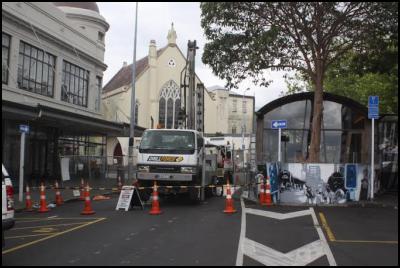CRL Water Runs Deep
CRL Water Runs Deep

The groundwater that lies beneath the proposed City Rail Link (CRL) station near Karangahape Road is being investigated in a two month test in Beresford Square.
Early drilling across the project found an unusually hard layer of sandstone up to 12 metres thick under Pitt Street and Karangahape Road through to the Central Motorway Junction. It found the deepest groundwater along the entire CRL route at the proposed Karangahape Road station. It is good quality and safe for drinking.
Now a pump test is being set up to see how the sandstone and its groundwater could affect station construction works and vice versa.
Project director Chris Meale says the sandstone is believed to have been broken apart into separate slabs in ancient times due to movement of the earth. This has caused cracks to develop across the slabs in many places and these are filled with groundwater.
Preliminary tests suggest the joints are relatively well connected, which allows groundwater to flow easily, about 30 times more easily than usual through this type of rock.
“The further investigations will include drilling holes to assess the distribution of the cracks, drilling vertical monitoring wells for the pump test and pumping out the groundwater for several weeks to understand how the groundwater interconnects across the area.”
This requires Beresford Square at Pitt St to be closed to vehicles for about two months while the work goes ahead. Pedestrian access isn’t affected but vehicle entry and exit from the square will be via Hopetoun Street.
“The CRL team has looked at alternative locations but the site chosen is where the well is best situated. We have worked with a local business owner to access power for the pump so that residents and businesses aren’t subject to a noisy generator, as the test will run 24/7,” says Mr Meale.
During the pump test, the effects on groundwater levels in the surrounding monitoring wells will be carefully recorded and any changes in ground surface level monitored by surveyors. At the end of the test, the wells will be monitored as groundwater levels return to normal.
This will provide reliable information for modelling the effects and changes to groundwater during the proposed CRL construction works to inform the design of the permanent works and show how the groundwater will behave after construction is completed.
“Interpretation of changing groundwater levels will provide significant information about the amount of groundwater stored in the well-cemented layer and how quickly it flows within and between the layers,” says Mr Meale.
ENDS


 Gordon Campbell: On What’s Wrong With The Treaty Principles Bill
Gordon Campbell: On What’s Wrong With The Treaty Principles Bill Te Pāti Māori: Government’s First Year A ‘Catastrophe For Māori’
Te Pāti Māori: Government’s First Year A ‘Catastrophe For Māori’ Department Of Internal Affairs: Samoan Citizenship Bill Passes Into Law
Department Of Internal Affairs: Samoan Citizenship Bill Passes Into Law NZ National Party: National Acknowledges The Passing Of Hon Nikki Kaye
NZ National Party: National Acknowledges The Passing Of Hon Nikki Kaye Mana Mokopuna: Children And Young People Share Vital Insights On Healing From Family Violence And Sexual Violence In New Report
Mana Mokopuna: Children And Young People Share Vital Insights On Healing From Family Violence And Sexual Violence In New Report NZ Government: PM Marks One Year In Government
NZ Government: PM Marks One Year In Government Helen Clark Foundation: Helen Clark Foundation Calls For Political Action To Reduce The Prevalence Of Junk Food And Improve Health Outcomes
Helen Clark Foundation: Helen Clark Foundation Calls For Political Action To Reduce The Prevalence Of Junk Food And Improve Health Outcomes


